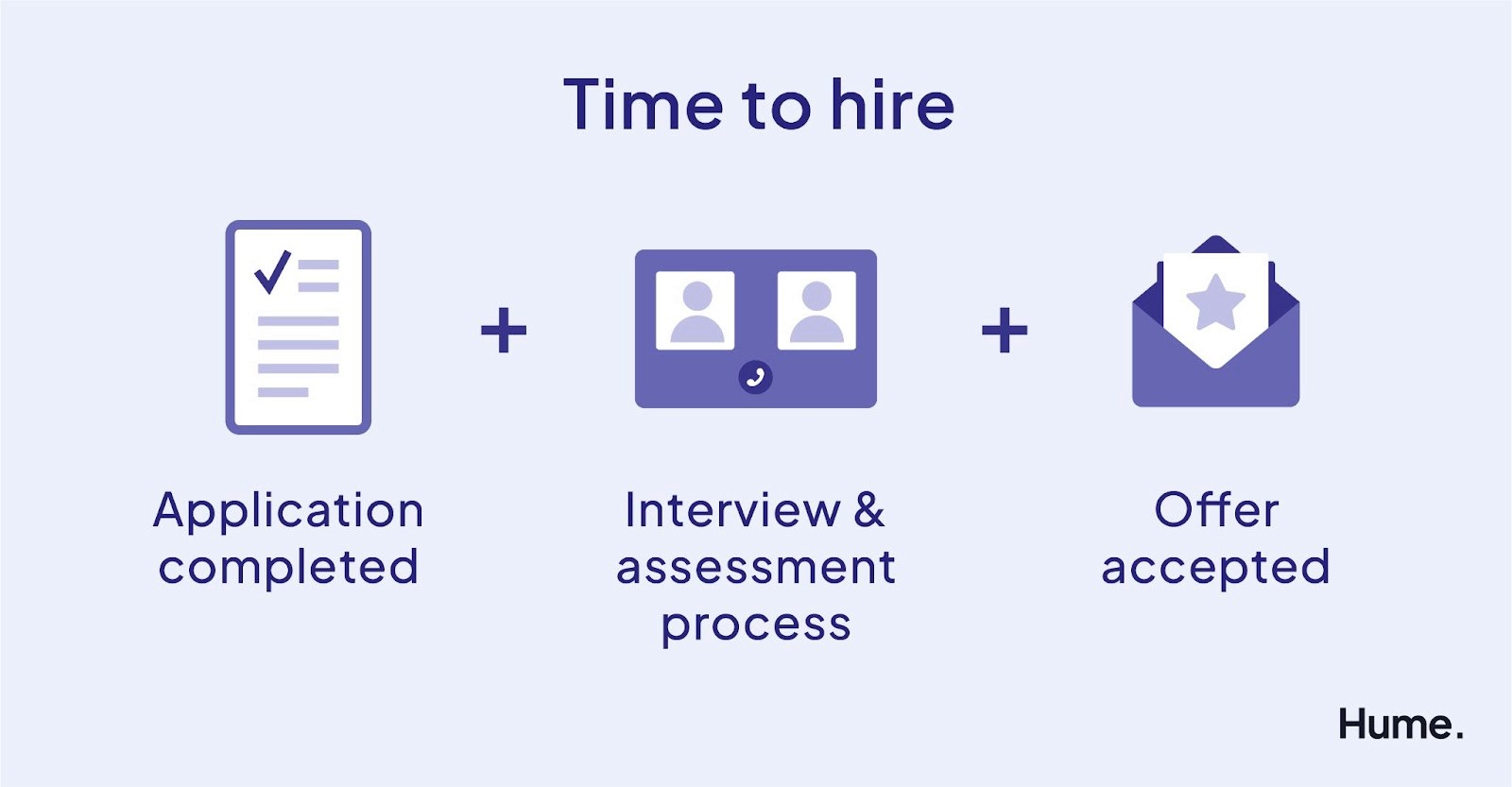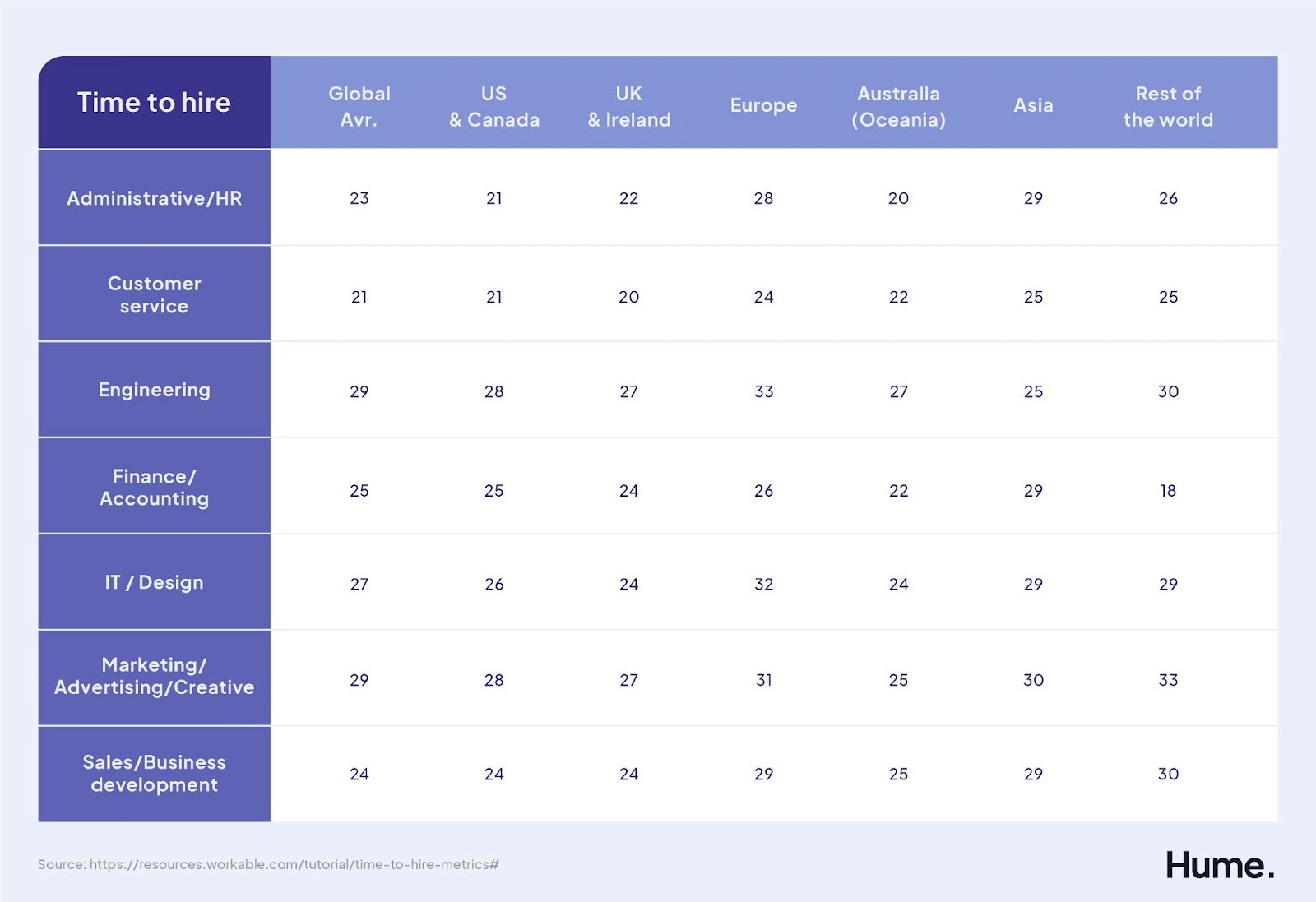Time to Hire: What It Is, How to Measure It, and How to Improve It

2023
The point of analyzing recruiting metrics is to learn about your hiring process, set benchmarks, and make informed tweaks to improve it — which is why we love to talk about ‘em.
Take for instance quality of hire, which is an important metric for showing how valuable a hire is to a business.
And of course there’s candidate experience, which may not be a metric in the traditional sense but is still a valuable factor for understanding the job applicant experience.
Today, we want to introduce you to yet another essential metric that every successful hiring team should be keeping track of: time to hire.
Explaining the time to hire metric
Hiring can get complex.
First, there are internal elements — budget, bandwidth, etc. — that impact hiring. And then there are external elements, like labor supply, seasonality, economic climate, immigration, and more. Time to hire smooths over all these factors to create a single efficiency metric that provides a crisp picture of how your recruitment efforts are performing.
Time to hire is measured in days elapsed between the moment a candidate first engages, typically by completing an application, and the moment they accept your employment offer.
It doesn’t measure up until the day a candidate begins working, because this is often skewed by things like taking time off between roles, finishing up work at their old job, and so on.

Time to hire vs. time to fill
Time to hire and time to fill are often used interchangeably. However, they have subtle differences for those who are really looking to use these metrics to their fullest impact.
Time to fill is the total number of days from when you post a job ad to when you have an accepted job offer. This metric is focused primarily on speed. It’s useful for business planning because it can help inform how long it will take to fill empty roles.
But time to hire only “starts the clock” when your eventual hire engages. So instead of measuring pure speed, it’s tracking how good your hiring team is at recognizing and closing suitable applicants once they’ve entered the pipeline — either on their own or via sourcing efforts.
In other words, it’s a powerful metric for measuring hiring efficiency.
Time to hire + candidate experience
Time to hire has a sizable impact on the all-important candidate experience.
Lengthy recruiting cycles — the average takes more than three weeks — are a leading reason why candidates withdraw their applications. Shortening your time to hire creates a candidate experience that applicants find more appealing.
Why time to hire is a key recruiting metric
Tracking time to hire will help you answer these essential questions, guiding your creation of a streamlined hiring and recruitment process:
How long does it take to determine the right candidate has entered the pipeline? Top talent is typically on and back off the market within ten days. You need to be able to spot and engage these applicants in your pipeline as soon as possible if you have any hope of hiring them — and keeping your time to hire on the low end.
Where are the bottlenecks in your recruiting and hiring process? Recruiting and hiring takes place in stages. There’s the application, the interviews, the offer stage, and so on. When you really dig into time to hire, you’ll start noticing if there are specific stages that either add too many days to the process or cause applicants to stall out altogether. You want to eliminate these.
How much time will it take to hire for this role again? Combine time to hire with time to fill for a highly accurate estimate of how long it will take to fill the same or a similar position. Average time to hire for all roles to give yourself a company-wide number — and a benchmark against which to measure your improvement efforts.
Are your hiring resources allocated appropriately? If you’ve really streamlined your process and are still looking to decrease your time to hire, you may need to introduce more personnel into the process. By measuring time to hire, you should be able to pinpoint what roles or which hiring stages need more resources to move quickly and smoothly.
Average time to hire benchmarks
Before getting to the more tactical tips for measuring and improving time to hire, we wanted to share some general benchmarks for time to hire, from across countries and industries.
These numbers (sourced from Workable) should be taken with a grain of salt. They’re just averages, which can be heavily impacted by outliers and unpredictable swings in the labor market. All we want you to do with these figures is get a feel for what time to hire can look like. The more you measure it within your organization, the more you’ll learn what time to hire should look like for you.

How to measure time to hire
Now that we’ve built a super solid foundation of what time to hire means, we can talk about how to measure it.
The calculation takes into account how many days a job was on the market, and at what point during that time your eventual hire entered the pipeline.
For example, let’s say 30 days passed from when a job ad went live to when a candidate accepted an offer, and that candidate applied on day 15.
That’s 30 days, minus 15 days. So your time to hire is 15 days. Not bad, according to the above benchmarks!
To determine your time to hire metric for similar roles, whole departments, or your entire organization, simply find the average of all their separate time to hire numbers.

6 ways to improve time to hire
Let’s talk about some super achievable tactics to create a time to hire with which you’re happier as an organization.
1. Streamline your interview process
Often, when something needs speeding up, it means cutting corners somewhere along the line. Unfortunately, when it comes to speeding up time to hire, those cuts often impact the interviewing process.
Not on our watch.
We know how vital great interviews are to securing amazing team members, so we created Hume to help you unlock all the valuable hiring data that interviews create — no corner-cutting needed.
Hume is today’s modern talent intelligence platform that helps interviewers record, transcribe, annotate, and summarize interviews with help from artificial intelligence. Hume rides along in the background of interviews so you can focus on candidates instead of on scribbling down notes. Hume means no more inaccurate recall and no more sneaky interview bias — don’t worry, it happens to all of us!
Instead, with Hume you end each interview with a beautiful document that you can revisit to compare candidates, question by question. And, you can even add highlights and create clips from interviews, which can be shared with your colleagues via the Hume platform. Finally, everyone can get on the same page and make fast, informed hiring decisions — even if they weren’t there for the interview itself.
Looking to operationalize effective, bias-free interview practices across your organization? We've got your back with our talent leader features. The playlist tool has everything you need to create and share interview coaching videos to shape your team into next-level interviewers.
Interviewing doesn’t have to drag down your time to hire metric. It can actually become a significant competitive advantage when you use Hume to empower fast, and fair, hiring.

2. Build a talent pipeline
Another way to reduce time to hire is to have a list of great candidates standing by that you can tap the second a role becomes available. This group of pre-screened candidates is known as a talent pipeline.
Here’s how to build and use a talent pipeline:
Think about the roles you hire for most. This will inform the types of candidates you fill your talent pipeline with.
Find the best places to source these types of candidates. That may be LinkedIn, an annual industry conference, or even referrals from your own team.
Make contact with ideal candidates, just letting them know who you are and that you’ll be keeping in touch.
Check in with your talent pipeline from time to time. Reach out to chat, share valuable information, ask them how their current role is treating them, etc.
When you’re ready to fill a job, these warm leads will already know who you are, so the conversation can move faster when you reach out to them with an opportunity!
3. Segment time to hire by stage and role
We mentioned earlier how, for almost every business, there are several stages to the recruiting and hiring process. These stages may include application completion, application review, screening, first interview, internal debriefing, second interview, and offer creation — and that’s pretty much the minimum.
To better understand and tighten up your time to hire, you need to look at each stage of the process to see where days can be shaved off. Perhaps you’ll discover that your team is waiting a week to review new applications, or that the back and forth during internal debriefings takes ten days on average because of everyone’s busy schedules. Information like this will help you zoom in on problem areas so you’re more effective at reducing time to hire.
This is also when we would recommend moving away from a company-wide time to hire and breaking it down by role, at least for now. Averages can blur what the hiring process actually looks like in different business areas. Some positions may already have a tidy time to hire that you’re happy with, and you may learn that some roles — specialties, C-suite, etc. — naturally take a while to fill correctly.
4. Apply pre-selection methods
By inserting pre-selection tools into the application process, you can get automated notifications the moment a great fit applies. This slices through the distractions and enables your team to engage qualified candidates quickly, reducing time to hire as a result.
Pre-selection tools test skills (coding, etc.), simulate jobs, determine situational judgment, test cognitive ability, review personality traits, and more to help identify whether a candidate will be a good fit for your role and your team.
Harver is a popular option, for example. Their customer Albert Heijn, a large European supermarket chain, reduced time to hire by 40% after implementing their pre-selection software.
5. Add quality of hire into the mix
As we’ve touched on already in this article, quality of hire is a critical metric for measuring how a new hire contributes to your company. By measuring quality of hire every time you find your time to hire, you will get a more well-rounded view of how quickly candidates were recruited as well as how they’re performing, how they’re increasing company value, how they’re retaining, etc. If time to hire looks great but quality of hire for those same candidates isn’t so hot, you might decide to spend a bit more time at various recruiting and hiring stages to find better fits.
That leads us to our last — but not least — tip.
6. Remember, less isn’t always more
The ultimate goal isn’t to get your time to hire as low as humanly possible.
As we just touched on, focusing only on how low you can go often leads to sourcing lower-quality candidates, as you’re looking at speed instead of quality.
Reviewing your time to hire is all about eliminating inefficiencies, not cutting corners or skipping steps. In the long run, all this gets you is ill-fitting employees whom you have to replace more often anyway.
So don’t go into the process of improving time to hire thinking about how you’re going to slash days off your numbers. Simply focus on optimization and efficiency, however that looks for your team.
Get a handle on your time to hire with Hume
Needless to say, there’s kinda a lot to think about when it comes to recruiting metrics, especially time to hire.
But that’s OK, you can handle it — especially when you employ the tools that are at your disposal.
Hume is here to help automate one of the most critical hiring stages, interviewing, and help you gain insights and share feedback faster than ever.
Sign up for Hume’s waiting list for early access to see for yourself. And until then, you can stay up to date with our developments over on LinkedIn.



